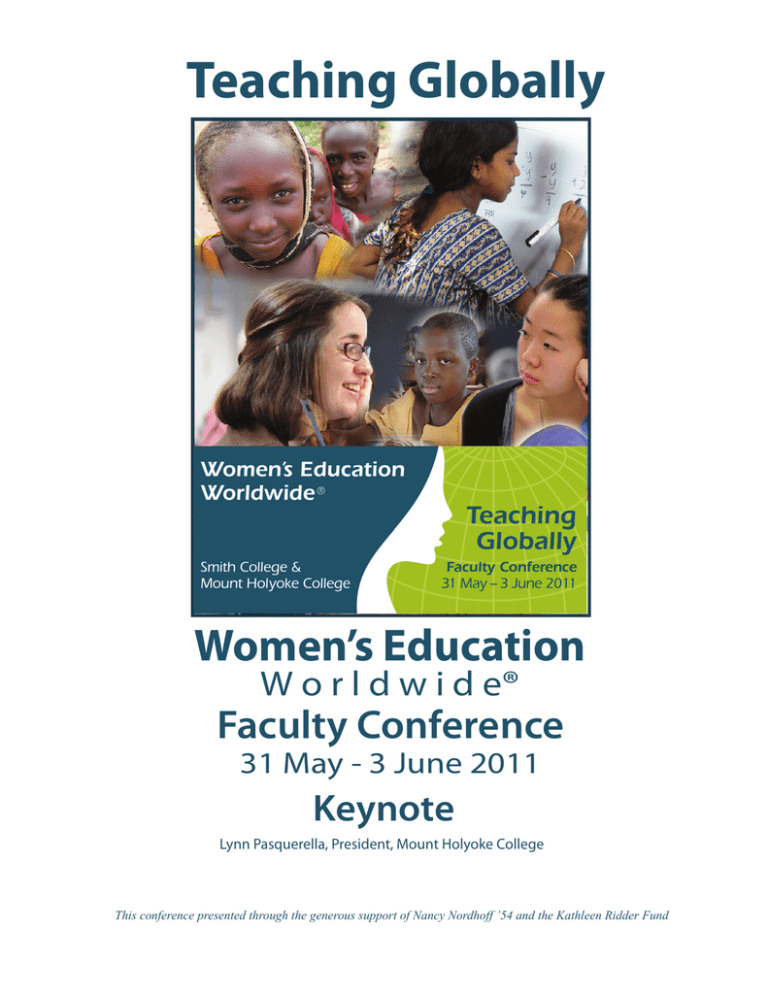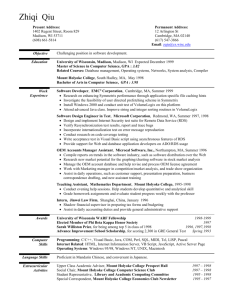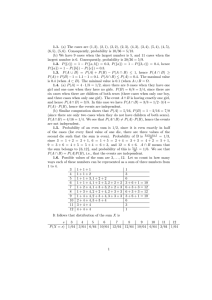Teaching Globally Women’s Education Faculty Conference Keynote
advertisement

Teaching Globally Women’s Education W o r l d w i d e® Faculty Conference 31 May - 3 June 2011 Keynote Lynn Pasquerella, President, Mount Holyoke College This conference presented through the generous support of Nancy Nordhoff ’54 and the Kathleen Ridder Fund Keynote: Addressing Cultural Competence and Context in Delivering Women’s Education Worldwide by Lynn Pasquerella President, Mount Holyoke College The Australian feminist philosopher Dale Spender once claimed that every century has its great women thinkers but that with each passing generation, the institutional politics of gender leaves women consigned to the “lower shelves” of cultural material and eventually forgotten. Because politics has kept our actual achievements out of the canon, we are forced to “rediscover” our female antecedents with every generation. Promoting women’s education worldwide is one of the most important safeguards against this type of generational forgetting. Yet, we need women’s education not only because it strengthens the institutional presence of women leaders who will work against the generational forgetting of women’s accomplishments, but also because of the urgent need to continue deepening and accelerating the pace of achievement for today’s women. As we come together from around the world to discuss shared strategies for collaborative research, teaching and developing curricula centered on meeting our common objectives of educating the next generation of women leaders, it is important to recognize some of the current trends related to internationalization of higher education and the impact of these trends on our work. “Internationalization” and “globalization” have become buzzwords in higher education, as there have been attempts by institutions around the world to increase diversity with respect to the faculty, student bodies and curricular offerings. Satellite campuses and dual-degree programs through international, inter-institutional partnerships hold the promise of preparing students to thrive in a world that is globally interdependent. At the curricular level, there have been calls by scholars such as Martha Nussbaum for an education for human development and a cosmopolitanism, the central tenet of which is a moral commitment to the whole of humanity and that students “should above all see themselves as citizens of a world of human beings.” 1 However, despite the rhetoric around the value of globalization in terms of preparing our students for the challenges of the future, in many cases, the push toward internationalization has prompted a more parochial and less cosmopolitan perspective. Thus, in Europe, where internationalization has become prominent in higher education across more than 40 countries, with the Bologna process and Lisbon strategy providing a European-wide framework for education, English has nevertheless become the common language. In the Netherlands alone, this global trend is reflected in close to 1,500 programs being taught in English. In addition, the pursuit and conveyance of scientific knowledge and other scholarship has become distinctly Westernized. The Westernization of scholarship raises particular concerns for those of us who are interested in truly cooperative teaching and research enterprises around the education of women worldwide. For, if we are to work as citizens of the world for the betterment of all women through education, we need to understand the extent to which Western scholarship has at times marginalized non-Western techniques and approaches as “Other.” Teaching Globally Faculty Conference The westernization of scholarship that has this “othering” effect parallels the westernization of feminism that was challenged more than two decades ago in response to a controversial article by philosopher Susan Moller Okin, entitled, “Is Multiculturalism Bad for Women?” I began thinking about these issues again when my son, Spencer, who is focusing on Critical Race Theory and Gender Studies in college, wrote a recent paper on Okin and the criticism that has emerged from so-called “Third-World Feminists.” In it, he addresses Okin’s question of “What should be done when the claims of minority cultures or religions clash with the norm of gender equality that is at least formally endorsed by liberal states (however much they continue to violate their practice)?”2 Okin’s own response, that there is a “considerable likelihood of tension between feminism and a multiculturalist commitment to group rights for minority cultures,” forces us to confront how to weigh the values of diversity and pluralism against practices of subcultures that appear oppressive to women.3 But, as many scholars have pointed out, the very way in which Okin poses the question reveals a western feminist discourse that posits the existence of the “third world woman” as “a singular monolithic subject.” Thus, according to feminist scholar Chandra Mohanty, “An analysis of ‘sexual difference’ in the form of a cross-culturally singular, monolithic notion of patriarchy or male dominance leads to the construction of a similarly reductive and homogeneous notion of. . . the ‘third world difference’—that stable, ahistorical something that apparently oppresses most if not all of the women in these countries. And it is in the production of this ‘third world difference’ that Western feminisms appropriate and ‘colonize’ the constitutive complexities which characterize the lives of women in these countries.4“ Mohanty argues that no matter how benevolently motivated, this type of objectification needs to be continually challenged. Its colonialist feel, results from the fact that “Western feminists alone become the true ‘subjects’ of this counterhistory. Third world women, on the other hand, never rise above the debilitating generality of their ‘object’ status.”5 Homa Hoodfar echoes Mohanty’s concerns in her article, “The Veil in Their Minds and on Our Heads”, when she says that by, “Failing to adequately contextualize non-Western societies, many researchers simply assume that what is good for Western middle-class women should be good for all other women.”6 This assumption is reflected in the perception by some that veiling equals ignorance and oppression rather than “a lived experience full of contradictions and multiple meanings.” 7 Likewise, in her essay, “The Problem of Speaking for Others,” Linda Alcoff warns that “Certain privileged locations are discursively dangerous. In particular, the practice of privileged persons speaking for or on behalf of less privileged persons has actually resulted (in many cases) in increasing or reinforcing the oppression of the group spoken for.” 8 Indeed, for Alcoff, the very act of speaking about another may be problematic because in 1 Women’s Education Worldwide: The Unfinished Agenda doing so, one may be “trying to describe their situation or some aspect of it” such that “one may . . . be speaking in place of them.” 9 This, she contends, is the crisis of representation that follows from the fact that “I am engaging in the act of representing the other’s needs, goals, situation, and in fact, who they are, based on my own situated interpretation.” 10 At times, “it is born of a desire for mastery, to privilege oneself as the one who more correctly understands the truth about another’s situation or as one who can champion a just cause and thus achieve glory and praise. And the effect of the practice of speaking for others is often, though not always, erasure and a reinscription of sexual, national, and other kinds of hierarchies.”11 This crisis of representation might be raised in connection with Nicholas Kristof and Sheryl WuDunn’s 2009 award-winning book Half the Sky. The authors assert unequivocally that education is the means of “unlocking women’s power as economic catalysts.” The problem is the way in which they take for granted the incompatibility of culture and gender. For they say, “the status and role of women is the greatest handicap of Muslim Middle Eastern societies today, the flaw that binds them from modernity.”12 For philosopher Uma Narayan, such descriptions are representative of a colonialist position that “reproduces a Western tendency to portray Third World contexts as dominated by the grip of ‘traditional practices’ that insulate these contexts from the effects of historical change.” 13 Like Narayan, I am concerned about the fact that two decades after Okin’s article, despite all of the conversation and critiques, there is still essentializing of cultures and gender in a way that undermines progress toward true globalization and cosmopolitanism. For example, in the year preceding the publication of Half the Sky, Nike launched its “Save a Girl, Save the World” campaign. The goal of the campaign is to eradicate poverty by investing in girls, creating the “girl effect.” The “girl effect” assumes that if girls are educated, economic empowerment will follow. While the intentions are good, this approach ignores the social and political realities that stand in the way of women’s empowerment, even after they have been educated. It also, as Anna Carella notes, relies on the essentialist view that women are innately more nurturing than men, and that women’s natural strengths lie in the home as the “chore doer” and “caretaker.” She says, “Rather than attempting to increase men’s domestic workload, the girl effect calls on women to carry the dual burden of housework and wealth creation” 14 The most compelling criticism, however, is that the girl effect reinforces the perception of women, and more generally people in developing countries, as needing “saving.” Carella uncovers the fact that, “In the girl effect video, the viewer is told to ‘imagine a girl living in poverty.’ Then the word ‘GIRL’ is displayed with flies buzzing around the letters, drawing on a stereotypical image often conjured by Westerners to depict sad, impoverished children in developing countries. Such images perpetuate the dichotomy of modern Western world vs. the backwards, charity-dependent rest of the world. 15 “ The discussion around essentialism of cultures and gender is relevant to our work today insofar as it draws attention to the fact that as we strive to develop collaborative research and curricula, we must avoid the domination of Westernized approaches. Within the classroom, this can be done by creating curricula that include the local knowledge systems that have been increasingly marginalized in a globalized world. The curriculum must reflect societal knowledge, including that of indigenous populations and underrepresented groups. Culturally competent teaching requires not Teaching Globally Faculty Conference only that students understand fully the social and cultural significance of local epistemologies but also how these epistemologies might be used to shape the way in which the curriculum is delivered. The Western domination of the production, organization and dissemination of research should also be challenged through the inclusion of locally informed research and scholarship. The need to rely on local knowledge is evident from the fact that Western models have fallen short in attempting to provide sustainable solutions for developing countries. The paradigm can be shifted, however, by developing curricula that both encourages members of local communities to engage in collaborative research and uses alternative approaches to research based on the socio-cultural contexts to inform the research model. In many instances, this shift will necessitate moving away from a research model based on individuals toward one built on attention to communities. I hope that these ideas will serve as a backdrop for today’s discussions. I am very much looking forward to all of today’s activities and want to thank all of you, again, for your commitment to working together to advance Women’s Education Worldwide. 1. Nussbaum, Martha. “Education for Profit, Education for Freedom.” Liberal Education: Association of American Colleges and Universities. Volume 95. No. 3 (2009): 6. 2. Kuchle, Spencer. “Okin, Multiculturalism and the Problem of Speaking for Others,” Unpublished paper. 3. Ibid. 4. Mohanty, Chandra Talpade, (1991) “Under Western Eyes: Feminist Scholarship and Colonial Discourses.” In Chandra Mohanty, Ann Russo and Lourdes Torres (Eds.), Third World Women and the Politics of Feminism (51-80) Bloomington: Indiana University Press. 5. Kuchle, p. 5. 6. Hoodfar, Homa. (1997) “The Veil in Their Minds and on Our Heads: Veiling Practices and Muslim Women,.” In Lisa Lowe and David Lloyd (Eds.), The Politics of Culture in the Shadow of Capital (248-279) Durham: Duke University Press 7. Ibid. 8. Kuchle, p. 6. 9. Ibid. 10. Op. cit. 11. Op. cit. 12. Kristoff, Nicholas and Sheryl WuDunn. (2009) Half the Sky New York: Random House. 13. Narayan, Uma. (1997) Dislocating Cultures: Identities, Traditions, and Third World Feminism. New York: Routledge, 14. Carella, Anna. “So Now We Have to Save Ourselves and the World Too? A Critique of ‘The Girl Effect,” www.aidwatch.com. 11 January 2011. 15. Ibid. 2 Thank You The organizers of the 2011 Women’s Education Worldwide Faculty Conference would like to thank the sponsors who made this conference possible through their very generous support. Thanks to all participants and their institutions for coming together to share thoughts, strategies, and initiatives toward realizing the potential and facing the challenges of women’s education in today’s world. Kathleen Ridder Fund in Honor of Jill Ker Conway Office of the Dean of Faculty, Mount Holyoke College Office of Complementary Program Development, Mount Holyoke College Nancy Nordhoff ’54, Mount Holyoke Smith College Project on Women and Social Change Smith College Global Studies Center Kahn Liberal Arts Institute Presidents’ Offices at Mount Holyoke College & Smith College



